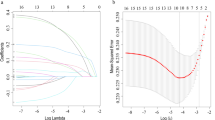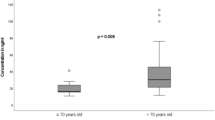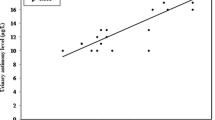Abstract
Background
Safety protocols are usually neglected among most of the trinitrotoluene (TNT)-exposed population, therefore, rendering the community prone to various occupational hazards. The current study highlights ring-shaped cataract and urinary metabolites of TNT among TNT-exposed population (n = 26) against a control group (n = 20).
Method
An observational case–control study was carried out in two groups: subjects exposed to TNT in Dir and Bajour Agency, Pakistan, and a control group from the base hospital. We determined the presence of ring-shaped cataract and urine metabolites of TNT using slit-lamp biomicroscope and gas chromatography–mass spectrometric analysis, respectively.
Results
Results substantiate a high level of urine metabolites for exposed subjects compared to the control group (p < 0.001). Age had no significant effect (p > 0.05) on the presence of ring-shaped cataract and the level of urinary metabolites of TNT, while duration of exposure showed significant effect (p < 0.001). Females showed high incidence of ring-shaped cataract and urinary metabolites of TNT than men ( p < 0.001). The mean age of the exposed subjects was 51 ± 14.38 (Mean ± SD) years. The mean year of exposure was 49 ± 5 (Mean ± SD) years.
Conclusion
This study showed TNT as a risk factor for the presence of ring-shaped cataract among TNT-exposed group in Pakistan. It is important to screen exposed community for the presence of ring-shaped cataract, and pre-clinical identification of TNT adducts to prevent systemic complications.

Similar content being viewed by others
Availability of data and material
Not applicable.
Code availability
Not applicable.
References
Burrows EP, Rosenblatt DH, Mitchell WR, Parmer DL (1989) Organic explosives and related compounds environmental and health considerations. Army Biomedical and M.D Development Lab, Maryland, p 40
Yaws CL (1997) Handbook of chemical compound data for process safety. In: Yaws CL (ed) Physical properties, 1st edn. Gulf Pub Co, Houston, Texas, pp 1–26
Gupta RC (2015) Handbook of toxicology of chemical warfare agents. In: Gupta RC (ed) Agents that can be used as weapons of mass destruction, 2nd edn. Elsevier, London, pp 1141–1184
Naderi M, Ghanei M, Shohrati M et al (2013) Systemic complications of trinitrotoluene (TNT) in exposed workers. Cutan Ocul Toxicol 32(1):31–34. https://doi.org/10.3109/15569527.2012.699486
Darrach MR, Chutjian A, Plett GA (1998) Trace explosives signatures from World War II unexploded undersea ordnance. Environ Sci Technol 32(9):1354–1358. https://doi.org/10.1021/es970992h
Kruse A, Hertel M, Hindsholm M, Viskum S (2005) Trinitrotoluene (TNT)-induced cataract in danish arms factory workers. Acta Ophthalmol Scand 83(1):26–30. https://doi.org/10.1111/j.1600-0420.2005.00361.x
Harkonen H, Karki M, Lahti A, Savolainen H (1983) Early equatorial cataracts in workers exposed to Trinitrotoluene. Am J Ophthalmol 95(6):807–810. https://doi.org/10.1016/0002-9394(83)90070-3
Hoenders HJ, Bloemendal H (1983) Lens proteins and aging. J Gerontol 38(3):278–286. https://doi.org/10.1093/geronj/38.3.278
Krol DS, Kolevatykh VP (1965) Ring-shaped cataract in chronic poisoning by trinitrotoluene (TNT). Oftalmol Zh 20(3):180–183
Zitting A, Szumanska G, Nickels J, Savolainen H (1982) Acute toxic effects of trinitrotoluene on rat-brain, liver and kidney-role of radical production. Arch Toxicol 51(1):53–64. https://doi.org/10.1007/Bf00279321
Savolainen H, Tenhunen R, Härkönen H (1985) Reticulocyte haem synthesis in occupational exposure to trinitrotoluene. Br J Ind Med 42(5):354–355. https://doi.org/10.1136/oem.42.5.354
Logan IM, Skripnichenko ZM, Tkachenko ET (1970) Trinitrotoluene (TNT) cataract in miners, its diagnosis and prevention. Oftalmol Zh 25(8):579–584
Kamboj A, Spiller HA, Casavant MJ et al (2018) Ocular exposures reported to United States Poison Control Centers. Ophthalmic Epidemiol. https://doi.org/10.1080/09286586.2018.1521982
Lewis-Younger CR, Mamalis N, Egger MJ et al (2000) Lens opacifications detected by slitlamp biomicroscopy are associated with exposure to organic nitrate explosives. Arch Ophthalmol 118(12):1653–1659. https://doi.org/10.1001/archopht.118.12.1653
Shohrati M, Najafian B, Saburi A et al (2014) Spirometric findings in TNT factory workers compared with unexposed controls. Asia Pac J Med Toxicol 3(3):110–114. https://doi.org/10.22038/apjmt.2014.3379
Haro E (1946) Hereditary disk-shaped (ring) cataract: report on a family, with microscopic examination of an eye. Arch Ophthalmol 36(1):82–100. https://doi.org/10.1001/archopht.1946.00890210085006
Yinon J (1990) Toxicity and metabolism of explosives. CRC Press (Taylor & Francis Group), Florida. https://doi.org/10.1201/9781439805299
Leung KH, Yao M, Stearns R, Chiu S-HL (1995) Mechanism of bioactivation and covalent binding of 2,4,6-trinitrotoluene. Chem Biol Interact 97(1):37–51. https://doi.org/10.1016/0009-2797(94)03606-9
Sabbioni G, Liu YY, Yan H, Sepai O (2005) Hemoglobin adducts, urinary metabolites and health effects in 2,4,6-trinitrotoluene exposed workers. Carcinogenesis 26(7):1272–1279. https://doi.org/10.1093/carcin/bgi078
Teir H, Grenquist-Nordén B (1990) Peripheral cataracts and trinitrotoluene exposure: a follow-up study. Acta Ophthalmol 68(195 S):49–51. https://doi.org/10.1111/j.1755-3768.1990.tb01957.x
Vorísek V, Pour M, Ubik K et al (2005) Analytical monitoring of Trinitrotoluene metabolites in urine by GC-MS. Part I. semiquantitative determination of 4-amino-2,6-dinitrotoluene in human urine. J Anal Toxicol 29(1):62–5. https://doi.org/10.1093/jat/29.1.62
Zhou AS (1990) A clinical study of trinitrotoluene cataract. Pol J Occup Med 3(2):171–176
Sabbioni G, Wei J, Liu YY (1996) Determination of hemoglobin adducts in workers exposed to 2,4, 6-trinitrotoluene. J Chromatogr B Biomed Appl 682(2):243–248. https://doi.org/10.1016/0378-4347(96)00083-7
Acknowledgements
We would like to acknowledge Armed Forces Institute of Pathology for help with systemic investigations.
Funding
This project was funded by the Al-Shifa Trust Eye Hospital, Jhelum Road, Rawalpindi, Pakistan.
Author information
Authors and Affiliations
Corresponding author
Ethics declarations
Conflict of interest
There is no conflict of interest associated with this study.
Ethical approval
This study was approved by the ethics and scientific committee of Al-Shifa trust eye hospital, Rawalpindi, Pakistan.
Consent to participate
This study was done in consideration of Helniski protocol, and data were collected with an informed consent form signed by subjects.
Consent for publication
Informed consent was taken for publication of the eye images.
Additional information
Publisher's Note
Springer Nature remains neutral with regard to jurisdictional claims in published maps and institutional affiliations.
Rights and permissions
About this article
Cite this article
Sarwat, S., Akhtar, A., Dayan, S.F.A. et al. Ring-shaped cataract and urinary metabolites among 2,4,6-trinitrotoluene exposed population of Pakistan. Int Ophthalmol 42, 2619–2624 (2022). https://doi.org/10.1007/s10792-022-02252-2
Received:
Accepted:
Published:
Issue Date:
DOI: https://doi.org/10.1007/s10792-022-02252-2




